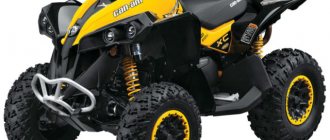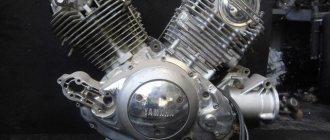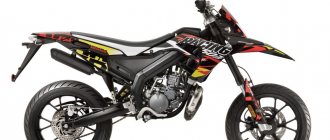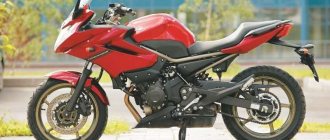The continuation of the VMAX line and the successor to the Yamaxa V-MAX 1200 version was the Yamaxa VMAX 1700 model, first presented at the exhibition in Tokyo in 2005 . Three years later, mass production begins. In the concern's model range, the motorcycle is named Yamaxa VMAX. No indication of volume or any additional symbols.
Like the previous model, the bike is immediately classified as a dragster (or unofficial classification - power cruiser).
Content
- 1 1985: Birth of a Legend
- 2 2008: The beginning of a new era
- 3 Engine
- 4 Compact tent-type combustion chamber
- 5 Iridium spark plugs
- 6 Reduced valve angle
- 7 Forged aluminum pistons
- 8 Connecting rods with layer carburization
- 9 Lightweight magnesium alloy lids
- 10 Brief history of the model
- 11 Electronic assistants and systems Yamaha V-max 1700:
- 12 Features:
- 13 Manual
1985: Birth of a Legend
In the 1980s, muscle cars with multi-liter V-eight engines were the undisputed authorities on US race tracks. In both automobile and motorcycle drag racing, large displacement engines have been king. A quarter of a century ago, Yamaha, imbued with the spirit of the times, introduced the stunning VMAX in 1985. The motorcycle was equipped with an engine with a displacement of 1198 cm3. A four-stroke V4 with four valves per cylinder and two camshafts in each cylinder head developed a power of 140 hp. This radical muscle bike became an instant legend, achieving iconic motorcycle status. Having sold almost a hundred thousand copies around the world in almost three decades and gone down in history as an exhibit of the Guggenheim Museum's 'Art of the Motorcycle', it has been produced until the present day. Nothing could compare to it, but now:
010_moto_1011_028
Like all recent motorcycles, the Yamaha VMAX runs on a lean mixture, which is why it gets very hot.
So an impressive radiator is not a whim of the designers, but a necessity. Like all recent motorcycles, the Yamaha VMAX runs on a lean mixture, which is why it gets very hot. So an impressive radiator is not a whim of the designers, but a necessity.
2008: The beginning of a new era
For the 2009 model year, Yamaha introduces the new VMAX, combining the latest advances in technology and design, delivering a stunning sense of acceleration and a unique look that continues the theme of the iconic appearance of the original model. With a high-tech chassis and powerful engine, the new VMAX is poised to capture the imagination of a new generation of adrenaline junkies, while at the same time inspiring the thousands of fans who made the original model so popular around the world.
New VMAX. Acceleration has never been so powerful! The group of engineers developing the new VMAX developed four main goals, the achievement of which should help them create a worthy successor to the original, now legendary VMAX:
— High power combined with excellent throttle response
— Distinct, precise and sharp steering
— Modern chassis with a unique exterior
— Compliance with EURO-3 exhaust toxicity standards
Guided by these principles, the designers created an all-new, state-of-the-art 4-cylinder V-twin engine with a displacement of 1679 cc, which is equipped with the latest versions of electronic engine management systems such as YCC-I and YCC-T, developed by Yamaha in accordance with with its new GENICH technology, the creators have also developed an entirely new low-profile frame assembled from cast and extruded aluminum elements. The engine is included in the power structure of the supporting system, which makes it possible to balance its rigidity and achieve excellent straight-line stability combined with refined handling in corners. These units make up a single, powerful, eye-catching appearance of the motorcycle, which can be described as “maximum engine, minimum attachments.” It is designed to focus attention on the "muscular" V4 engine. Thanks to the use of a fuel injection system, a lambda probe and a three-way catalytic converter, the new engine meets Euro 3 emission requirements. Brutal engine power combined with advanced motorcycle engineering and manufacturing technology and a radical appearance give the new VMAX an unforgettable combination of acceleration and innovation.
004_moto_1011_028
When creating the engine, the designers tried to achieve a “V-Boost feeling” at any speed and speed.
During the tests, different cubic capacities were tested (up to 2 liters). But with increasing volume, due to increased inertia, the engine greatly lost its responsiveness to turning the throttle. When creating the engine, the designers tried to achieve a “V-Boost feeling” at any speed and speed. During the tests, different cubic capacities were tested (up to 2 liters). But with increasing volume, due to increased inertia, the engine greatly lost its responsiveness to turning the throttle.
Engine
All-new V-twin 4-stroke, 4-cylinder, liquid-cooled engine*
The new VMAX is equipped with a 4-stroke, 4-cylinder V-shaped (65?) liquid-cooled engine* with a displacement of 1679 cm 3 with a DOHC gas distribution system (with two camshafts in each cylinder head), designed to you will enjoy unforgettable acceleration created by the incredible power of this power unit. With a 90 mm bore, 60 mm stroke (instead of 76 x 66 mm on its predecessor) and a compression ratio of 11.3, the engine produces 147.2 kW (200 hp)** at 9000 rpm and 166.8 Nm (17 kgm) of torque at 6500 rpm.
The new VMAX is equipped with the most advanced electronic engine management system in this motorcycle category. Impressive power and torque are the result not only of a 40% increase in engine displacement, but also of a completely new power unit design with the latest control system, the most advanced in its class. Yamaha's GENICH*** technology is an advanced technical concept that uses a state-of-the-art electronic control system to enhance the motorcycle's performance and capabilities.
The new VMAX is equipped with GENICH technology's YCC-I (Yamaha Chip Controlled Intake) and YCC-T (Yamaha Chip Controlled Throttle) systems, which are key to the new engine's high power output. The new engine is the first of Yamaha's V-fours to feature a new high-tech fuel injection system combined with YCC-I and YCC-T systems, which provide previously unattainable levels of power and acceleration from all speeds.
But this engine offers much more than an impressive acceleration feel and advanced electronic control technology. Not only does it deliver an unmatched linear torque curve, but it also delivers instant response and unparalleled power delivery across the entire crankshaft speed range, making the new VMAX superior on both the racetrack and the road.
- The maximum speed of VMAX is electronically limited to 220 km/h, and before the limiter is activated, ? miles
- For France, according to current legislation, engine power is limited to 78.1 kW (106 hp) at 5,200 rpm and torque is limited to 145.2 Nm (14.8 kgm) at 5,000 rpm.
- GENICH stands for Genesis in Electronic engineering aimed at New, Innovative Control technology based on Human sensitivities - Generation of electronic systems developed using new innovative control technology based on human sensitivities.
Compact tent-type combustion chamber
To achieve the fast, efficient combustion that allows the new VMAX engine to achieve optimal performance, our engineers developed a new four-valve tent-type combustion chamber. For an engine with a displacement of an impressive 1679 cm 3 and a cylinder diameter of 90 mm, such a combustion chamber is surprisingly compact. Thanks to this, it was possible to free up space to accommodate a new, original valve drive system. In a traditional engine with a DOHC (double-shaft, camshaft in the cylinder head) timing system, the intake and exhaust camshafts are driven by a single chain. However, to reduce the size of the cylinder head, Yamaha engineers developed an entirely new valve drive system. In it, only the intake camshaft is driven by a chain, from which the exhaust camshaft is driven by a gear transmission. The combination of chain and gear drives made it possible to reduce the distance between the camshafts and make the cylinder head more compact.
Reduced valve angle
Using a compact camshaft drive allowed Yamaha engineers to set the valves at a lower angle. The intake valve angle is now 14? , and there are 15 graduations? (on the current model, the installation angles of the intake and exhaust valves are 18?), which gives a total of 29?. This small angle allows the engine to be minimized and the shape of the intake and exhaust ports in the cylinder head optimized. In addition to reducing the angle between the valves, Yamaha engineers reduced the overall weight of the valve train by using an external valve lash adjustment system instead of the internal valve lash adjustment system used on the previous model.
Cylinder block with camber angle 65? and the central location of the drive chains of the gas distribution mechanism. One of the priorities facing the developers of the new VMAX was to make the engine as compact as possible. Despite the fact that the working volume has increased by almost 40% (1679 cm 3 versus 1198 cm 3), the engine turned out to be very compact. In order to reduce the longitudinal size of the engine, the cylinder camber angle was made equal to 65? instead of 70?, like the original VMAX. Reducing the camber angle of the massive cylinders increased mass centralization, which had a positive effect on handling, and also reduced the longitudinal size of the engine by 27 mm compared to the original model. The reduction in engine size was also facilitated by the central location of the timing chain. Although the new VMAX's bore is 18% larger than its predecessor, the new engine's cross-sectional dimensions are approximately the same as those of the existing model and its height is only 6.5 mm greater. By applying new solutions, Yamaha engineers managed to achieve the extremely difficult goal of maintaining the minimum dimensions of the engine, the displacement of which has increased by 40%!
Dimensions and weight
The curb weight of the motorcycle is 310 kg . Chrome version, for the USA - 311 kg .
Dry - 292 kg .
The dimensions were not much different from the prototype:
- the bike has grown in length - from 2,301 to 2,396 mm ;
- width - from 796 to 821 mm ;
- in height - from 1,161 to 1,191 mm ;
Wheelbase - 1371 mm . The saddle height has increased by 40 mm - 775 mm .
For whom is it intended?
The low seating position of the bike, as well as the low seat height, makes for a comfortable ride for a person of average and short stature.
The low-set seat provides a slightly relaxed seating position with a slight forward lean.
The classic seating position, which does not require much bending of the knees or bending over the steering wheel, can also suit tall people.
Layer carburized connecting rods
Layer carburized connecting rods were first introduced in 2004 on the YZF-R1. Now this technology is also used in the highly boosted 1679 cc engine of the new VMAX.
Electronic control system for the length of the intake tract (YCC-I - Yamaha Chip Controlled Intake) In general, a longer intake tract improves engine performance at low and medium crankshaft speeds, and a shorter one, increasing the intake flow rate, leads to an increase in performance at high speeds. The YCC-I (Yamaha Chip Controlled Intake) control system was designed to vary the length of the intake tract depending on engine speed, which improves cylinder filling. When the crankshaft speed exceeds 6650 rpm, the electronic control unit commands the servomotor to instantly reduce the length of the intake tract to 54 mm, which allows increasing engine efficiency up to the maximum crankshaft speed.
Fuel Injection and Yamaha Chip Controlled Throttle (YCC-T) Another innovative system featured on the new VMAX is the YCC-T (Yamaha Chip Controlled Throttle) system, which is designed using the company's expertise. Yamaha is developing similar systems for sports motorcycles.
This system has a very high computational speed, monitoring engine operating parameters every 0.001 seconds, which allows it to instantly respond to driver control actions. The new VMAX's YCC-T Electronic Throttle Control system helps achieve unrivaled throttle response and precise torque delivery in all conditions, and prevents engine stalls when the throttle is opened too quickly.
Aggressively styled aluminum intakes and large volume air cleaner Mounted at the front of the false tank, the aggressively styled aluminum intakes give the new VMAX a muscular appearance and direct oncoming airflow directly into the large air cleaner housing, which approximately twice the size of the existing model. By supplying the engine with a large volume of clean, cool air, the large air filter works with the YCC-I system to provide the engine with increased power output.
Rear wheel drive with virtually maintenance-free driveshaft Whether you own an existing VMAX and are looking to upgrade to a new one, or you're one of those who have never owned a VMAX but want to experience the thrill of acceleration delivered by the new V4 - Either way, you'll appreciate the high reliability and low maintenance requirements of the new rear wheel drive system. To transfer the increased engine power, the VMAX features a new rear wheel drive system. By optimizing the gear ratios of the gearbox at the output of the gearbox and the final drive, our designers were able to achieve a reduction in the size of the final drive housing. Reducing the number of gear teeth from 33 (on the existing model) to 29 allowed the final drive housing to be thinner and its diameter reduced to 188 mm, which gave the bike an athletic rear end and emphasized its “muscular” image.
4-1-2-4 exhaust system with short titanium mufflers For superior performance, the new VMAX features a 4-1-2-4 exhaust system with upswept titanium short mufflers. After the exhaust gases leave the combustion chambers, they enter four exhaust pipes, and from there into a common chamber, which at the exit divides the exhaust system into left and right parts, each of which has two mufflers at the end. This creates a 4-1-2-4 pattern. The oxygen sensor (lambda probe) determines the amount of oxygen in the exhaust gases and, through the electronic injection control system, regulates the fuel supply to the engine. In combination with a three-way catalytic converter, they ensure that the new VMAX meets Euro 3 environmental standards. Four short, upward-facing mufflers have a conical shape and give the exhaust a powerful, mellifluous sound that will announce your arrival with its unique pulsation. The high-quality mufflers are made from lightweight titanium and are bead-peened to give them a black finish that matches the frame and engine.
Yamaha Vmax 1700
Yamaha VMAX 1700
Some people need speed and risk - these people choose sports bikes, drive at 300 km/h, stand on the rear wheel and say hello to Ferrari owners. Others love comfort and confidence, they ride their Harleys, grow beards and consider themselves kings of the road. And then there are those who like the golden mean - who need convenience and speed at the same time. For them, Yamaha recently introduced its new 2009 Yamaha VMAX.
The design of the VMAX has undergone changes, but it will go on sale exactly as you see it now. Five-speed gearbox,
200 “horses”, a 1.6-liter engine - all this will make even the most hardened skeptics respect the 400-kilogram bike.
Minor shortcomings, such as not the best handling, and the brakes, which were not good enough for such a powerful motorcycle, were present in
They promised to eliminate the previous version of the VMAX from Yamaha, so a new version of this bike, which will soon go on sale at a price of 18 thousand.
dollars, promises to become quite popular among motorcycle enthusiasts.
Specifications:
- Engine: 4-stroke, DOHC, 4-valve head, V-type 4-cylinder 65 degrees
- Cooling: liquid
- Displacement: 1,679 cc
- Bore x stroke: 90.0 x 66.0 mm
- Compression ratio: 11.3:1
- Maximum power: 200 hp @ 9,000 rpm
- Max. torque: 166.8 Nm (17.0 kg-m) @ 6,500 rpm
- Lubrication system: Dry
- Fuel system: injector
- Clutch: Dry, multi-plate, diaphragm spring
- Ignition: TCI
- Starter: electric starter
- Gearbox: 5-speed
- Main gear: cardan
- Primary ratio 1.509
- Secundary ratio 3.082
- Gear ratio-1st gear 2.375
- Gear ratio-2nd gear 1.810
- Gear ratio-3rd gear 1.400
- Gear ratio-4th gear 1.115
- Gear ratio-5th gear 0.935
- Tank volume: 15 l
- Oil tank: 5.9 l
- Chassis: Aluminum, Diamond-shaped
- Front suspension: Telescopic fork, ø 52 mm
- Stroke: 120 mm
- Rear suspension: Swingarm
- Stroke: 110 mm
- Steering angle: 31°
- Trail: 148 mm
- Front brake: double disc, ø 320 mm
- Rear brake: single disc, ø 298 mm
- Front tire: 120/70 R18M/C (59V)
- Rear tire: 200/50 R18M/C (76V)
- Length: 2.395 mm
- Width: 820 mm
- Height: 1,190 mm
- Seat height: 775 mm
- Wheelbase: 1,700 mm
- Minimum ground clearance: 140 mm
- Gross weight: 310 kg
New, Exclusive VMAX: Power, Acceleration and Adrenaline Yamaha introduces the all-new, exclusive VMAX.
The 21st century technology incorporated into the engine and chassis allows it to deliver amazing power, giving the owner an unparalleled sense of acceleration and adrenaline rush. The new VMAX features Yamaha's latest advances in advanced engine and chassis technology, such as YCC-I and YCC-T electronic engine management systems, an aluminum frame and six-piston radial brakes to keep 200 horsepower under control. .s.* and 167 Nm of torque. 1985: Birth of a Legend
In the 1980s, muscle cars with multi-liter V-eight engines were the undisputed authorities on US race tracks. In both automobile and motorcycle drag racing, large displacement engines were the real thing. A quarter of a century ago, Yamaha, imbued with the spirit of the times, introduced the stunning VMAX in 1985. The motorcycle was equipped with an engine with a displacement of 1198 cm3. A four-stroke V4 with four valves per cylinder and two camshafts in each cylinder head developed a power of 140 hp. This radical muscle bike became an instant legend, achieving iconic motorcycle status. Having sold almost a hundred thousand copies around the world in almost three decades and gone down in history as an exhibit of the Guggenheim Museum's 'Art of the Motorcycle', it has been produced until the present day. Nothing could compare to it, but now:
2008: The beginning of a new era
For the 2009 model year, Yamaha introduces the new VMAX, combining the latest advances in technology and design, delivering a stunning sense of acceleration and a unique look that continues the theme of the iconic appearance of the original model. With a high-tech chassis and powerful engine, the new VMAX is poised to capture the imagination of a new generation of adrenaline junkies, while at the same time inspiring the thousands of fans who made the original model so popular around the world. New VMAX. Acceleration has never been so powerful! The team of engineers developing the new VMAX developed four main goals, the achievement of which should help them create a worthy successor to the original, now legendary VMAX: - High power combined with excellent response to the rotation of the handle - Distinct, precise and sharp steering - A modern chassis with a unique exterior - Compliance with EURO-3 emission standards Guided by these principles, the designers have created a completely new, state-of-the-art 4-cylinder V-engine with a displacement of 1679 cm 3, which is equipped with the latest versions of electronic engine control systems, such as YCC-I and YCC-T, developed by Yamaha in accordance with its new GENICH technology. The creators also developed an all-new low-profile frame assembled from cast and extruded aluminum elements. The engine is included in the power structure of the supporting system, which makes it possible to balance its rigidity and achieve excellent straight-line stability combined with refined handling in corners. These units make up a single, powerful, eye-catching appearance of the motorcycle, which can be described as. It is designed to focus attention on the V4 engine. Thanks to the use of a fuel injection system, a lambda probe and a three-way catalytic converter, the new engine meets Euro 3 emission requirements. Brutal engine power combined with advanced motorcycle engineering and manufacturing technology and a radical appearance give the new VMAX an unforgettable combination of acceleration and innovation.
Engine
All-new V-type 4-stroke, 4-cylinder, liquid-cooled engine* The new VMAX is equipped with a 4-stroke, 4-cylinder, V-type (65?) liquid-cooled engine* with a displacement of 1,679 cc and DOHC timing system ( with two camshafts in each cylinder head) designed to give you unforgettable acceleration created by the incredible power of this power unit. With a 90 mm bore, 60 mm stroke (instead of 76 x 66 mm on its predecessor) and a compression ratio of 11.3, the engine produces 147.2 kW (200 hp)** at 9000 rpm and 166.8 Nm (17 kgm) of torque at 6500 rpm. The new VMAX is equipped with the most advanced electronic engine management system in this motorcycle category. Impressive power and torque are the result not only of a 40% increase in engine displacement, but also of a completely new power unit design with the latest control system, the most advanced in its class. Yamaha's GENICH*** technology is an advanced technical concept that uses a state-of-the-art electronic control system to enhance the motorcycle's performance and capabilities. The new VMAX is equipped with GENICH technology's YCC-I (Yamaha Chip Controlled Intake) and YCC-T (Yamaha Chip Controlled Throttle) systems, which are key to the new engine's high power output. The new engine is the first of Yamaha's V-twins to feature a new high-tech fuel injection system combined with YCC-I and YCC-T systems, which provide previously unattainable levels of power and acceleration from all speeds. But this engine offers much more than an impressive acceleration feel and advanced electronic control technology. Not only does it deliver an unmatched linear torque curve, but it also delivers instant response and unparalleled power delivery across the entire crankshaft speed range, making the new VMAX superior on both the racetrack and the road. * The maximum speed of VMAX is electronically limited to 220 km/h, while ? miles ** For France, in accordance with current legislation, engine power is limited to 78.1 kW (106 hp) at 5200 rpm and torque is 145.2 Nm (14.8 kgm) at 5000 rpm min. *** GENICH stands for Genesis in Electronic engineering aimed at New, Innovative Control technology based on Human sensitivities - Generation of electronic systems developed using new innovative control technology based on human sensations.
Compact tent-type combustion chamber
To achieve the fast, efficient combustion that allows the new VMAX engine to achieve optimal performance, our engineers developed a new four-valve tent-type combustion chamber. For an engine with a displacement of an impressive 1679 cm 3 and a cylinder diameter of 90 mm, such a combustion chamber is surprisingly compact. Thanks to this, it was possible to free up space to accommodate a new, original valve drive system. In a traditional engine with a DOHC (double-shaft, camshaft in the cylinder head) timing system, the intake and exhaust camshafts are driven by a single chain. However, to reduce the size of the cylinder head, Yamaha engineers developed an entirely new valve drive system. In it, only the intake camshaft is driven by a chain, from which the exhaust camshaft is driven by a gear transmission. The combination of chain and gear drives made it possible to reduce the distance between the camshafts and make the cylinder head more compact.
Iridium spark plugs
In addition to highly efficient combustion chambers and an innovative electronic control system, the new VMAX also features iridium spark plugs. These special spark plugs are used in most high-performance engines and allow efficient combustion throughout the engine's entire operating range.
Reduced valve angle
Using a compact camshaft drive allowed Yamaha engineers to set the valves at a lower angle. The intake valve angle is now 14? , and there are 15 graduations? (on the current model, the installation angles of the intake and exhaust valves are 18?), which gives a total of 29?. This small angle allows the engine to be minimized and the shape of the intake and exhaust ports in the cylinder head optimized. In addition to reducing the angle between the valves, Yamaha engineers reduced the overall weight of the valve train by using an external valve lash adjustment system instead of the internal valve lash adjustment system used on the previous model. Cylinder block with camber angle 65? and the central location of the drive chains of the gas distribution mechanism. One of the priorities facing the developers of the new VMAX was to make the engine as compact as possible. Despite the fact that the working volume has increased by almost 40% (1679 cm 3 versus 1198 cm 3), the engine turned out to be very compact. In order to reduce the longitudinal size of the engine, the cylinder camber angle was made equal to 65? instead of 70?, like the original VMAX. Reducing the camber angle of the massive cylinders increased mass centralization, which had a positive effect on handling, and also reduced the longitudinal size of the engine by 27 mm compared to the original model. The reduction in engine size was also facilitated by the central location of the timing chain. Although the new VMAX's bore is 18% larger than its predecessor, the new engine's cross-sectional dimensions are approximately the same as those of the existing model and its height is only 6.5 mm greater. By applying new solutions, Yamaha engineers managed to achieve the extremely difficult goal of maintaining the minimum dimensions of the engine, the displacement of which has increased by 40%!
Forged aluminum pistons
Another example of the use of high technology to improve engine performance is the use of forged aluminum pistons in its design.
Layer carburized connecting rods
Layer carburized connecting rods were first introduced in 2004 on the YZF-R1. Now this technology is also used in the highly boosted 1679 cc engine of the new VMAX.
Electronic control system for the length of the intake tract (YCC-I - Yamaha Chip Controlled Intake)
In general, a longer intake tract improves engine performance at low and medium crankshaft speeds, while a shorter one, by increasing the intake flow rate, leads to increased performance at high speeds. The YCC-I (Yamaha Chip Controlled Intake) control system was designed to vary the length of the intake tract depending on engine speed, which improves cylinder filling. When the crankshaft speed exceeds 6650 rpm, the electronic control unit commands the servomotor to instantly reduce the length of the intake tract to 54 mm, which allows increasing engine efficiency up to the maximum crankshaft speed.
Fuel injection and electronic throttle control (YCC-T - Yamaha Chip Controlled Throttle)
Another innovative system featured on the new VMAX is the YCC-T (Yamaha Chip Controlled Throttle) system, which draws on Yamaha's experience in developing similar systems for sports motorcycles. This system has a very high computational speed, monitoring engine operating parameters every 0.001 seconds, which allows it to instantly respond to driver control actions. The new VMAX's YCC-T Electronic Throttle Control system helps achieve unrivaled throttle response and precise torque delivery in all conditions, while also preventing engine overdrive.
Aggressively styled aluminum air intakes and large volume air filter
Aggressively styled and mounted at the front, on either side of the false tank, aluminum air intakes give the new VMAX the look and flow of incoming air directly into the large air cleaner housing, which is approximately twice the size of the existing model. By supplying the engine with a large volume of clean, cool air, the large air filter works with the YCC-I system to provide the engine with increased power output.
Rear wheel drive via virtually maintenance-free drive shaft
Whether you're an existing VMAX owner looking to upgrade to a new one, or you're one of those who've never owned a VMAX but want to experience the thrill of acceleration the new V4 brings to the bike, you'll appreciate the high reliability and low maintenance requirements of the new rear wheel drive system. To transfer the increased engine power, the VMAX features a new rear wheel drive system. By optimizing the gear ratios of the gearbox at the output of the gearbox and the final drive, our designers were able to achieve a reduction in the size of the final drive housing. Reducing the number of gear teeth from 33 (on the existing model) to 29 allowed the final drive housing to be thinner and its diameter reduced to 188 mm, which gave the bike an athletic rear end and enhanced its appearance.
4-1-2-4 exhaust system with short titanium mufflers
For superior performance, the new VMAX features a 4-1-2-4 exhaust system with short, upward-facing titanium mufflers. After the exhaust gases leave the combustion chambers, they enter four exhaust pipes, and from there into a common chamber, which at the exit divides the exhaust system into left and right parts, each of which has two mufflers at the end. This creates a 4-1-2-4 pattern. The oxygen sensor (lambda probe) determines the amount of oxygen in the exhaust gases and, through the electronic injection control system, regulates the fuel supply to the engine. In combination with a three-way catalytic converter, they ensure that the new VMAX meets Euro 3 environmental standards. Four short, upward-facing mufflers have a conical shape and give the exhaust a powerful, mellifluous sound that will announce your arrival with its unique pulsation. The high-quality mufflers are made from lightweight titanium and are bead-peened to give them a black finish that matches the frame and engine.
Lightweight magnesium alloy covers
The design of the new VMAX is characterized by the use of high-quality materials, which not only give the motorcycle an exclusive look, but also instills a sense of pride in the owner. To reduce the overall weight of the motorcycle and give it a premium look, the clutch, alternator and final drive housing covers are made from lightweight magnesium alloy.
Brief history of the model
2009 - start of production and sales. Model: Yamaha VMX17 V-Max (all markets). Factory designation: 2S31, 2S32, 2S33, 2S34, 2S35, 2S36, 2S37.
2010 - no significant changes. Model: Yamaha VMX17 V-Max (all markets). Factory designation: 2S38, 2S39, 2S3A, 2S3B, 2S3C, 2S3D.
2011 - no significant changes. Model: Yamaha VMX17 V-Max (all markets). Factory designation: 2S3E, 2S3F, 2S3G, 2S3H, 2S3J, 2S3K.
2012 - no significant changes. Model: Yamaha VMX17 V-Max (all markets). Factory designation: 2S3L, 2S3M, 2S3N, 2S3P, 2S3R, 2S3S, 2S3T.
2013 - no significant changes. Model: Yamaha VMX17 V-Max (all markets). Factory designation: 2S3U, 2CE1, 2CE2, 2CE3, 2CE4.
2014 - no significant changes. Model: Yamaha VMX17 V-Max (all markets). Factory designation: 2S3V, 2S3W, 2CE5, 2CE6, 2CE7, 2CE8.
2015 - no significant changes. Model: Yamaha VMX17 V-Max (all markets). Factory designation: 2CE9, 2CEA, 2CEB, 2CEC, 2CED, 2CEE, 2CEF.
2016 - no significant changes. Model: Yamaha VMX17 V-Max (all markets). Factory designation: 2CEG, 2CEH, 2CEJ, 2CEK, 2CEL, 2CEN, 2CEP.
2017 - no significant changes. Model: Yamaha VMX17 V-Max (North America, Japan). Factory designation: 2CER, 2CES, 2CET, 2CEU.
2018 - no significant changes. Model: Yamaha VMX17 V-Max (North America).
2019 - no significant changes. Model: Yamaha VMX17 V-Max (North America).
2020 - no significant changes. Model: Yamaha VMX17 V-Max (North America).









